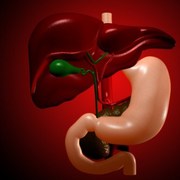Hepatic steatosis is a disease characterized by the excessive accumulation of fat in the cells of the liver. Nonalcoholic fatty liver disease or NAFLD describes the extra fat in the liver found in people who drink no or little amounts of alcohol. Obesity is the most common cause of NAFLD. Alcoholic fatty liver disease results from excessive alcohol consumption. Fatty liver disease develops in any one who drinks more than two ounces of alcohol daily. Hepatic steatosis is treatable and reversible if diagnosed early. However, if untreated, excessive fat accumulation in the liver leads to inflammation and scarring.
Usually, NAFLD causes no symptoms. In cases of NAFLD with symptoms, common complaints are fatigue, pain in the upper right area of the abdomen, and weight loss. According to the Merck website, people with alcoholic fatty liver disease can be asymptomatic but one third of them will have an enlarged liver. Alcoholic fatty liver disease is the first consequence of excessive alcohol consumption. The disease progresses to inflammation of the liver called steatohepatitis and advances to cirrhosis.
The diagnosis of fatty liver disease is made by analyzing the results of liver function tests. Liver function tests are blood tests that measure liver enzyme levels. The transaminases, ALT and AST are the liver enzymes that are most often elevated with any type of inflammation of the liver. In the presence of alcoholic fatty liver disease, AST is usually higher than ALT. Routine blood work performed on an obese person usually detects mild elevations in liver enzymes. This is the initial step in diagnosing NAFLD. An ultrasound of the liver is done to confirm the diagnosis of fatty liver disease. The accumulation of excess fat is visible on this imaging study.
Weight loss is the recommended treatment for NAFLD. Patients are advised to lose weight by diet, exercise, medication, and surgery, if necessary. Medications that lower cholesterol levels are prescribed. Abstinence from alcohol is the recommended treatment for alcoholic fatty liver disease. The excess fatty deposits resolve within two weeks of abstaining from alcohol. Supplements of vitamins and minerals are recommended to replenish any deficiencies caused by excessive drinking.
Sources: Mayo Clinic
American College of Gastroenterology






Add a CommentComments
There are no comments yet. Be the first one and get the conversation started!